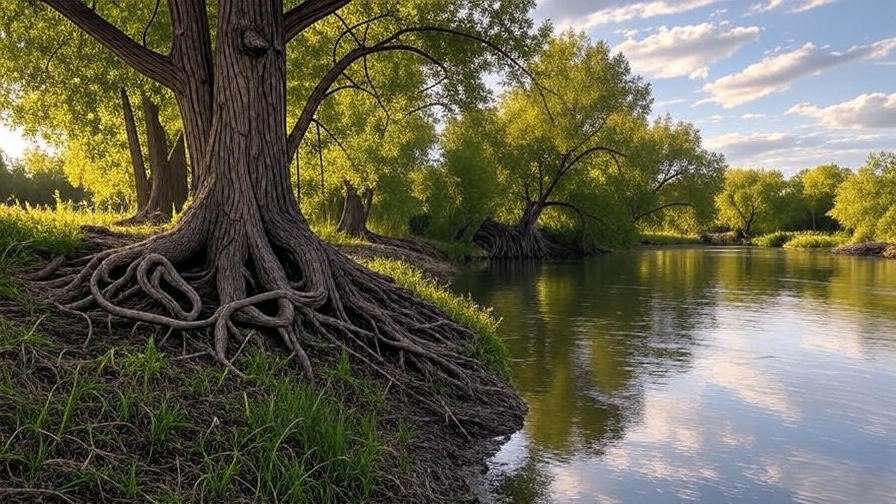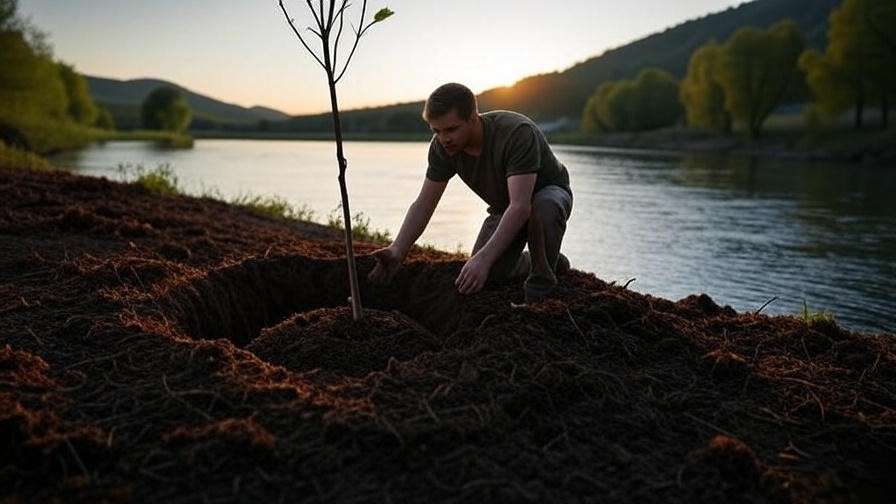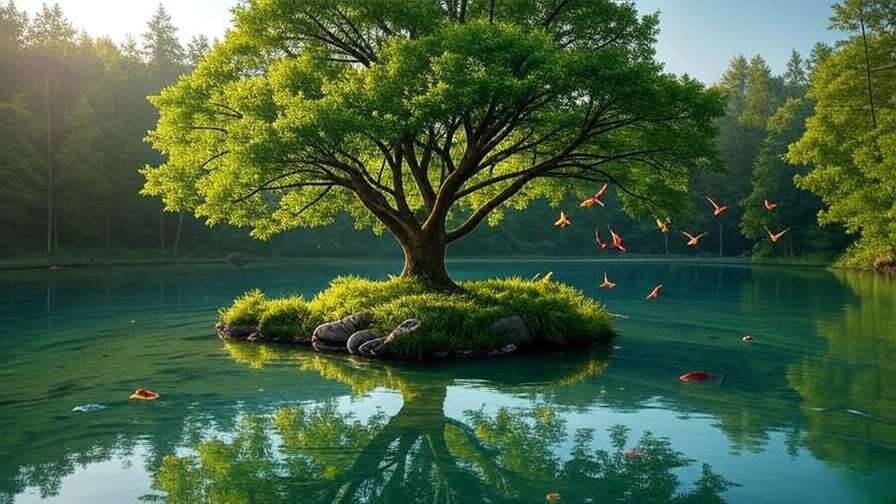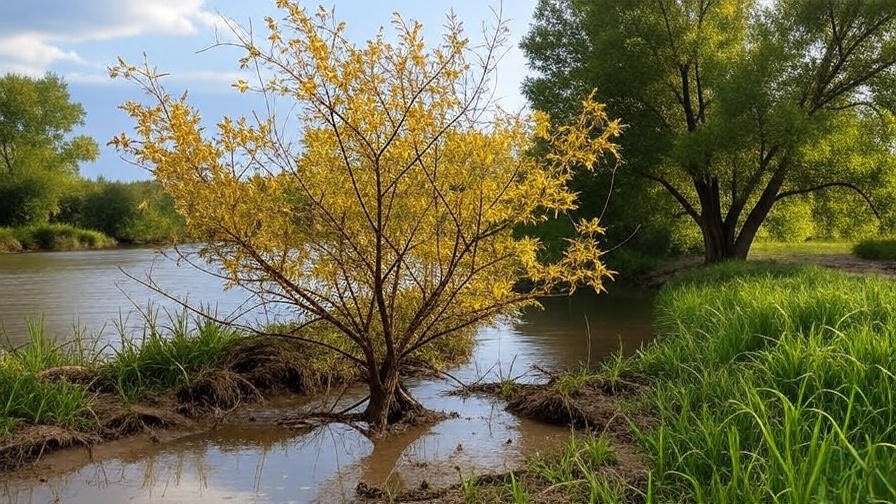Picture a majestic tree standing proudly by a shimmering river, its roots drinking deeply from the water, its leaves dancing in the breeze. A tree planted by the water isn’t just a poetic image—it’s a living testament to nature’s resilience and beauty. 🌊 Whether you’re a homeowner dreaming of a vibrant riverside garden or a conservationist aiming to restore a local waterway, this guide reveals the secrets to planting and nurturing riparian trees that thrive in water-rich environments. With expert insights and practical steps, you’ll learn how to grow trees that stabilize soil, boost biodiversity, and transform your landscape into a thriving ecosystem. 🌿 Backed by decades of arboriculture expertise and environmental science, this article is your roadmap to success. Let’s dive in! 🏞️
1. Understanding Riparian Trees: What Makes a Tree Planted by the Water Special? 🌊
Defining Riparian Trees and Their Unique Environment
Riparian trees grow in the unique zones along rivers, streams, wetlands, or lakes—areas where water shapes the landscape. These trees, often referred to as a tree planted by the water, are ecological powerhouses. They prevent soil erosion, filter pollutants, and provide habitats for wildlife like birds, fish, and pollinators. 🦋 Their roots anchor riverbanks, while their canopies offer shade, cooling water temperatures for aquatic life. Unlike upland trees, riparian species thrive in saturated soils, with adaptations like deep, flexible roots and tolerance for periodic flooding. 🌳 Understanding their role is the first step to successful planting.

The Biblical and Cultural Significance of “Tree Planted by the Water”
The phrase tree planted by the water draws from Psalm 1:3, which describes a flourishing tree as a symbol of strength and prosperity. 📖 This imagery resonates today, inspiring gardeners and conservationists to cultivate trees that embody resilience. Riparian trees reflect this metaphor, thriving in challenging, wet conditions while enriching their surroundings. By planting them, you’re not just growing a tree—you’re creating a legacy of environmental stewardship. 🌱
Expert Insight: “Riparian trees are the backbone of healthy watersheds,” says Dr. Jane Thompson, a certified arborist with 25 years of experience. “Their ability to stabilize ecosystems makes them essential for sustainable landscaping.” 🧑🌾
2. Choosing the Right Tree Species for Riparian Planting 🌲
Top Tree Species for Water-Rich Environments
Selecting the right tree is critical for success in riparian zones. Here are some top species known for thriving near water:
- Willows (Salix spp.): Fast-growing, flood-tolerant, with flexible roots ideal for riverbanks. 🌿
- Cottonwoods (Populus spp.): Towering trees that excel in wet soils and provide wildlife habitats. 🦅
- Alders (Alnus spp.): Nitrogen-fixing roots improve soil fertility in soggy conditions. 🌱
- Sycamores (Platanus occidentalis): Stately trees with strong roots and striking bark, perfect for large spaces. 🌳
Opt for native species to support local ecosystems and avoid invasive plants that can disrupt biodiversity. For example, black willow is a native star in North American riparian zones, while invasive species like tamarisk can harm waterways. 🐦
Matching Trees to Your Climate and Soil Type
Your tree’s success depends on matching species to your region’s climate and soil. Check your USDA hardiness zone to ensure compatibility. For instance, red maples thrive in zones 3–9, while bald cypress prefers warmer zones 5–10. 🌍 Test soil moisture with a simple DIY method: dig a 12-inch hole, fill it with water, and time how long it takes to drain. Fast-draining soils may need drought-tolerant species, while slow-draining soils suit true riparian trees. A soil pH test (aim for 6.0–7.5) ensures optimal nutrient uptake. 🧪
| Tree Species | USDA Zones | Soil Preference | Flood Tolerance |
|---|---|---|---|
| Black Willow | 2–8 | Wet, loamy | High |
| Cottonwood | 3–9 | Moist, sandy | High |
| Red Alder | 4–7 | Wet, nitrogen-poor | Moderate |
| Sycamore | 4–9 | Moist, well-drained | Moderate |
Tip: Contact your local cooperative extension service for native species recommendations tailored to your area. 🌿

3. Planting a Tree by the Water: Step-by-Step Guide 🌱
Site Selection and Preparation
Choosing the perfect spot is crucial. Look for areas with consistent moisture but avoid zones prone to severe flooding that could uproot young trees. 💧 Ensure the site gets at least 6 hours of sunlight daily and has enough space for the tree’s mature size—cottonwoods, for example, can spread 50 feet or more. Check for overhead power lines or underground utilities to avoid conflicts. 🏡 Prepare the soil by adding organic matter like compost to improve structure and nutrient retention, especially in clay-heavy riparian zones.
Planting Techniques for Riparian Success
Timing is everything—plant in early spring or fall for optimal root establishment. 🌸 Dig a hole twice as wide as the root ball but no deeper, ensuring the root flare sits at soil level. Gently spread the roots to encourage outward growth. After planting, apply a 2–3 inch layer of organic mulch (like wood chips) to retain moisture and suppress weeds, keeping it away from the trunk to prevent rot. 🌲 Stake young trees in windy areas but remove stakes after one year to promote strong roots.
Example: In a 2023 Ohio riverbank restoration project, volunteers planted 200 black willows using these techniques, achieving a 95% survival rate after two years. 📸

4. Caring for Your Riparian Tree: Maintenance Secrets 🌳
Watering and Nutrient Management
Riparian trees often rely on natural water sources, but supplemental irrigation is key during establishment or dry spells. Water deeply once a week for the first year, ensuring the root zone stays moist but not waterlogged. 💦 Use organic fertilizers like compost tea to boost nutrients without overloading wet soils. Watch for signs of trouble: yellowing leaves may indicate nutrient deficiency, while wilting could signal overwatering. A soil test every 2–3 years keeps you informed about nutrient levels and pH. 🧪
Pruning and Pest Control
Prune in late winter to shape young trees and remove dead or crossing branches. Use clean, sharp tools to prevent disease spread. ✂️ Common riparian pests include aphids and scale, while diseases like root rot thrive in overly wet soils. Inspect trees regularly and use eco-friendly solutions like neem oil for pests or improved drainage for rot prevention. Avoid chemical pesticides to protect nearby water ecosystems. 🌱
Expert Tip: Inoculate roots with mycorrhizal fungi during planting to enhance water and nutrient uptake in soggy soils. 🍄
5. Environmental Benefits of Trees Planted by the Water 🌍
How Riparian Trees Transform Ecosystems
A tree planted by the water does more than beautify—it transforms ecosystems. Their roots stabilize soil, reducing erosion by up to 70% in some studies. They filter pollutants like nitrogen and phosphorus, improving water quality for aquatic life. 💧 Canopies provide shade, lowering water temperatures and supporting fish like salmon. Wildlife, from herons to bees, rely on these trees for food and shelter. 🦅🐝

Climate Change Mitigation
Riparian trees are climate heroes. A mature tree can sequester 48 pounds of carbon annually, helping combat climate change. 🌱 In urban areas, their shade reduces heat islands, lowering local temperatures by 5–10°F. Restoration projects show that riparian forests can cut flood damage costs by millions, as seen in a 2021 FEMA study. 📊
Insight: A USDA Forest Service report highlights that riparian zones cover just 1% of land but support 80% of regional biodiversity. 📚
6. Common Mistakes to Avoid When Planting Near Water 🚫
Pitfalls That Harm Riparian Trees
Planting a tree planted by the water comes with unique challenges, and avoiding common mistakes is key to success. One major error is planting too close to the water’s edge, where constant saturation can suffocate roots. Aim for a spot 5–10 feet from the bank to balance moisture access and root health. 💧 Another mistake is choosing invasive species like Russian olive or tamarisk, which can outcompete native plants and disrupt ecosystems. Always research species to ensure they’re non-invasive in your region. 🌾 Finally, neglecting long-term care—such as skipping pruning or ignoring soil health—can stunt growth or lead to tree failure. ⏳
Troubleshooting Tree Health Issues
If your tree shows signs of stress, act quickly. Yellowing leaves often signal nutrient deficiencies, particularly nitrogen or iron, which a soil test can confirm. Wilting or drooping may indicate overwatering or poor drainage; improve aeration by loosening compacted soil or adding organic matter. 🧪 Stunted growth could point to root damage from flooding or pests. If problems persist, consult a certified arborist for a professional diagnosis. Early intervention can save your tree! 📞
Tip: Keep a journal to track your tree’s growth, noting changes in leaves, bark, or soil conditions to catch issues early. 📝

7. Enhancing Your Landscape with Riparian Trees 🎨
Designing a Water-Friendly Garden
A tree planted by the water can be the centerpiece of a stunning, eco-friendly landscape. Pair riparian trees with complementary shrubs like red osier dogwood or groundcovers like sedges to create a layered, biodiverse garden. 🌸 These plants enhance soil stability and attract pollinators, boosting your yard’s ecological value. Position trees strategically to frame views or provide shade for seating areas, blending beauty with function. For example, a sycamore’s mottled bark can add visual drama against a river’s sparkle. 🖼️
Community and Conservation Projects
Riparian trees are perfect for community-driven restoration. Join local watershed groups to plant trees along degraded streams, improving water quality and wildlife habitats. 🤝 Involve schools or neighbors to foster a sense of stewardship—kids love planting days! A 2022 project in Oregon saw 50 volunteers plant 300 alders along a creek, reducing erosion by 60% within three years. These efforts not only restore ecosystems but also build community pride. 🌳
Success Story: In Virginia, a small town transformed a polluted riverbank into a thriving riparian forest by planting native willows and engaging local students, earning a state conservation award. 📸
Conclusion: Growing Your Own Tree Planted by the Water 🌿
Planting a tree planted by the water is more than a gardening project—it’s a commitment to environmental health and beauty. By choosing the right species, planting with care, and maintaining diligently, you can grow trees that thrive in wet conditions while supporting ecosystems. 🌱 Start small with one tree or go big with a restoration project—either way, you’re creating a legacy for future generations. Share your journey with our community, and let’s inspire each other to nurture nature! 📲 As Psalm 1:3 reminds us, a tree planted by the water “yields its fruit in season and its leaf does not wither.” Let’s make that vision a reality. 🌳
FAQs ❓
- What’s the best tree to plant near a river?
Native species like black willow or cottonwood are ideal due to their flood tolerance and ecosystem benefits. Check with your local extension service for region-specific options. 🌲 - How do I know if my soil is too wet for planting?
Dig a 12-inch hole, fill it with water, and time the drainage. If it takes over 8 hours, improve drainage with organic matter or choose highly flood-tolerant species. 🧪 - Can I plant non-native trees by the water?
Avoid non-natives to prevent ecological harm. Native trees support local wildlife and are better adapted to your climate. Consult experts for safe choices. 🌿 - How often should I water a newly planted riparian tree?
Rely on natural water sources but supplement with deep watering weekly during the first year, especially in dry spells. Monitor soil moisture to avoid overwatering. 💧 -
What are the signs my tree is struggling?
Look for yellowing leaves, wilting, or stunted growth. Section 6 offers solutions, like soil tests or drainage improvements, to address these issues. 🍂













